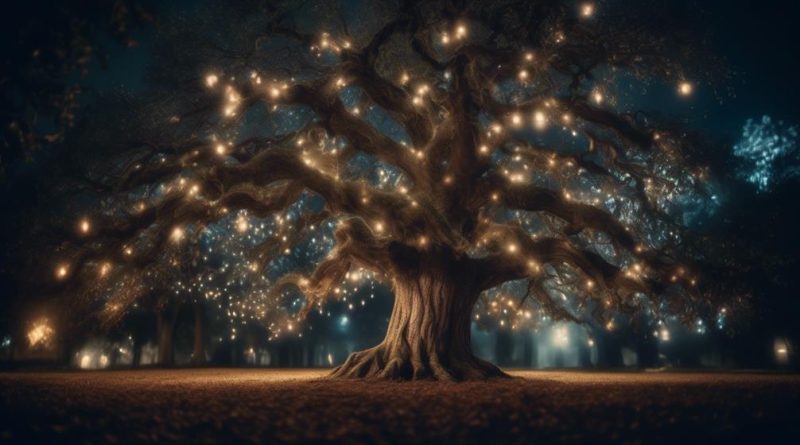Illuminating Giants: A Guide to Tree Light-Wrapping
Welcome to the enchanting world of tree light-wrapping. In the realm of outdoor decor, few things are as captivating as trees adorned with twinkling lights. The art of illuminating giants not only adds a touch of magic to your surroundings but also creates a mesmerizing visual spectacle.
As we embark on this illuminating journey together, we will uncover the secrets behind safely and effectively transforming your trees into breathtaking focal points. But before we unveil the step-by-step instructions, let's explore the essential safety considerations that will ensure a successful and incident-free venture.
Brace yourself for a captivating exploration of this art that will leave you eager to bring your trees to life.
Key Takeaways
- Safety is a top priority when wrapping trees with lights, including selecting a clear day with minimal wind, ensuring the ladder is properly supported and held by a second person, and using GFCI-protected extension cords.
- Before starting, it is important to test the equipment and make sure the extension cord and string lights are in good working condition.
- Proper measurement of the tree's circumference and height is necessary to determine the number of string light sets needed and the total length of lighting required.
- When wrapping the outdoor string lights, start from the lowest visible point on the tree or a few feet higher, wrap the lights around the trunk or branches depending on the type of tree, and securely fasten the lights using natural twine, plant tape, or zip ties while avoiding any damage to the tree's growth.
Safety Considerations
When it comes to safely wrapping lights around a tree, there are several important considerations to keep in mind.
One of the common safety hazards is the improper positioning of the ladder. It is crucial to ensure that the ladder is set up properly to prevent accidents. The ladder should be supported evenly at the top and bottom and angled at 75 degrees.
Additionally, having a second person hold the ladder can provide added stability.
Another important aspect of ladder safety is selecting a clear day with no rain or snow in the forecast and minimal wind. This reduces the risk of slipping or losing balance while on the ladder.
Equipment and Materials Needed
To successfully wrap lights around a tree, it is essential to gather the necessary equipment and materials for the task at hand. Here are four items you will need for outdoor lighting installation and string light design ideas:
- Ladder: A sturdy ladder is crucial for reaching the height of the tree safely. Make sure it is positioned at a 75-degree angle and supported evenly.
- Tape measure: Accurate measurements of the tree's circumference and height are needed to determine the amount of string lights required and ensure proper spacing.
- Outdoor extension cord: An outdoor-rated extension cord with GFCI protection is necessary to power the string lights. Ensure it is elevated off the ground for safety.
- Outdoor string lights: Choose high-quality, waterproof string lights that are suitable for outdoor use. These lights will add a magical touch to your tree when wrapped properly.
Setting Up the Ladder and Testing Equipment

Position the ladder at a 75-degree angle with even support to ensure stability and safety during the light-wrapping process.
Before climbing the ladder, it is important to follow tips for ladder safety. Select a clear day with no rain or snow forecasted and minimal wind. Ensure the extension cord has GFCI protection and is elevated off the ground. Have a second person hold the ladder for added stability. Test the extension cord and string lights beforehand to ensure they are in proper working order.
It is also crucial to properly maintain outdoor string lights. Wrap the lights around a flat piece of cardboard for easy carrying and unraveling.
Measuring the Tree and Running the Extension Cord
After ensuring proper ladder setup and testing the equipment, the next step in the tree light-wrapping process involves measuring the tree and running the extension cord. To guide you through this process, here are four important considerations:
- Calculating spacing: Measure the circumference and height of the tree to determine the amount of string light sets needed. Calculate the spacing between lights for even distribution, ensuring a balanced and visually appealing result.
- Ensuring proper elevation: Wrap the extension cord several times around the base of the tree trunk, making sure the connection between the cord and lights is elevated. This prevents water damage and reduces the risk of tripping hazards.
- Determining total length: Based on your calculations, determine the total length of lighting required to cover the tree adequately. This will help you plan the number of string lights needed and ensure you have enough to complete the project.
- Running the extension cord: Once measured, securely run the extension cord from a power source to the base of the tree, ensuring it is safely elevated and protected from the elements.
Wrapping and Securing the Outdoor String Lights

To ensure a secure and visually appealing display, it is crucial to wrap and secure the outdoor string lights properly on your tree. This not only prevents tree damage but also allows for creative string light designs. Here is a step-by-step guide to wrapping and securing the lights:
| Step | Description |
|---|---|
| 1 | Start at the lowest visible point on the tree or a few feet higher if the base is visible |
| 2 | Wrap the lights around the trunk, gradually moving upward |
| 3 | Check spacing between lights for even distribution |
| 4 | For deciduous trees, wrap lights around larger branches and loop around smaller ones |
| 5 | For coniferous trees, wrap lights around the entire exterior |
| 6 | Use natural twine, planting tape, or zip ties to secure the lights |
| 7 | Prevent shifting in heavy winds or during snow/ice storms |
| 8 | Remove any fasteners to avoid damaging the tree's growth |
Professional Assistance Considerations
Hiring a professional for assistance with wrapping outdoor string lights on a tree can provide expert guidance and ensure a safe and professional-looking installation. When considering whether to hire a professional, there are several factors to take into account:
- Complexity of the project: If the tree is large or has a complicated structure, it may be challenging for an inexperienced person to properly wrap the lights. A professional will have the expertise to handle such situations.
- Time constraints: If you have a busy schedule or limited time available, hiring a professional can save you valuable time and effort.
- Safety concerns: Working at heights can be dangerous, especially if you lack the necessary experience and equipment. Professionals are trained to work safely and can minimize the risk of accidents.
- Cost considerations: While hiring a professional may incur additional costs, it can be a worthwhile investment. Professionals have the necessary tools and materials, and their expertise ensures a high-quality and long-lasting installation.
Frequently Asked Questions
Can I Use Indoor String Lights for Outdoor Tree Wrapping?
Outdoor string lights are more durable for tree wrapping compared to indoor string lights. Creative alternatives to secure the lights include using natural twine, planting tape, or zip ties. These materials provide stability and prevent damage to the tree's growth.
How Do I Calculate the Spacing Between the String Lights on the Tree?
To calculate the spacing between string lights on a tree, measure the circumference and height of the tree. Determine the number of string light sets needed based on desired spacing for even distribution and maintaining symmetrical appearance.
Are There Any Specific Safety Considerations for Wrapping Lights Around Coniferous Trees?
Fire safety precautions for wrapping lights around coniferous trees include using outdoor-rated lights, avoiding overloading electrical circuits, and keeping lights away from dry or flammable materials. To protect tree health, avoid wrapping lights too tightly and remove fasteners carefully to prevent damage.
Can I Use Zip Ties to Secure the String Lights to the Tree?
While zip ties can be used to secure string lights to a tree, it is recommended to use alternatives such as natural twine or planting tape. These options provide flexibility and prevent damage to the tree's growth. For creating a unique light pattern, start at the lowest visible point and wrap the lights around the trunk, gradually moving upward.
How Do I Prevent the String Lights From Tangling While Wrapping Them Around the Tree?
To prevent tangling while wrapping string lights around a tree, start at the bottom and work your way up, keeping the lights taut and untwisted. Use a smooth and efficient wrapping technique, ensuring each loop is neatly placed and secured.
Conclusion
In conclusion, tree light-wrapping can be a beautiful way to enhance your outdoor space, but it is important to prioritize safety and proper technique. By following the steps and precautions outlined in this guide, you can safely and effectively illuminate your trees.
Remember, seeking professional assistance if needed is always a wise choice.
Now, here's an interesting statistic: Did you know that properly wrapped outdoor string lights can reduce the risk of accidents or damage by up to 80%? This highlights the importance of taking the necessary precautions to ensure a safe and visually stunning result.




